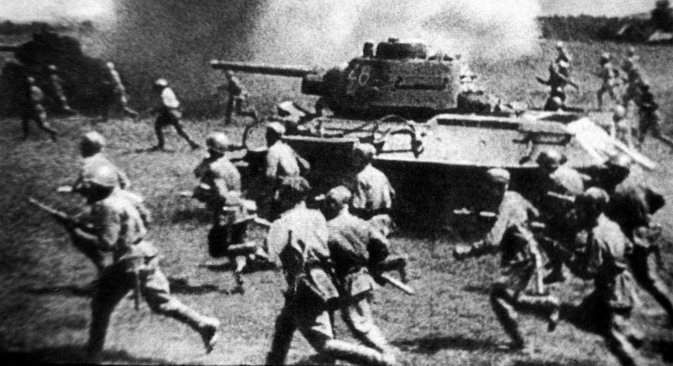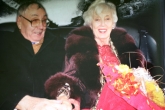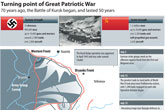Eyewitness accounts of the Battle of Kursk

Soviet soldiers wreaked havoc on the elite German armored forces’ morale, after which they definitively lost faith in a German victory. Source: ITAR-TASS
Prokhorovsky field is silent. Only the sound of bells are heard tolling intermittently, calling parishioners to services in the Prokhorovka Peter and Paul Church, which was built on donations from the people, in memory of the soldiers who died on the Kursk Bulge.
Seventy years ago, a terrible battle raged here, when, in the vicinity of Prokhorovka, the largest tank battle in all of world history unfolded. Here, Soviet Guard units clashed head-on with the Wehrmacht’s elite SS Panzer divisions.
The Battle of Kursk is also known as the Battle of the Kursk Bulge, named for the curved front of the battle formed by Soviet troops (see battle map).
“We will have lunch in Kursk!”
Fighting on the southern face of the Kursk Bulge actually began on July 4, 1943.
The major events, however, unfolded in the early morning of July 5, when the Germans struck the first massive blow with their armored formations. That morning, the commanding officer of the 1st SS Panzer Division Leibstandarte SS Adolf Hitler, Obergruppenführer Josef Dietrich, drove up to his Tigers and heard an officer shout to him, “We will have lunch in Kursk!”
But the SS had neither lunch nor dinner in Kursk.
Prokhorovka
At 8:30 a.m. on July 12, Soviet attack forces launched a counter-offensive against the troops of the 4th Panzer Army.Acutely aware that a successful Soviet offensive could crush the entire Army Group South, German Cmdr. Erich von Manstein threw all available forces into an effort to meet the Soviet attack. A bitter struggle broke out on a front that spanned more than 124 miles.
The fiercest fighting broke out on July 12, on the so-called Prokhorovka bridgehead—a strip of land captured by the Germans after a close-fought battle over the course of July 11. Having taken the bridgehead, the main body of the SS Panzer Corps turned around and took action. The Soviet command then launched its main attack.
Soviet Cmdr. Pavel Rotmistrov: “After several minutes of firing on the move, the attacking echelon of our 29th and 18th Tank Corps cut into the Nazi ranks with a thrust forward—a rapid assault literally through the enemy ranks. […]
Their Tigers and Panthers [types of tanks], deprived in the melee of their advantage in firepower, which they had enjoyed at the beginning of the offensive in the clash with our other armored formations, were now completely astonished by the Soviet T-34 tanks and even by the [lighter] T-70s from shorter distances.
Smoke and dust swirled all over the battlefield. The earth shook from the powerful blasts. Tanks struck each other and, having grappled, could not cut themselves loose and fought to the death, or until one of them flashed a light or came to a halt with broken tracks. Tanks that had been knocked, but whose weapons were functioning, however, continued to fire.”
Soviet tank officer Yevgeny Shkurdalov: “I knocked the first tank out while I was moving along a railroad platform, and literally one hundred meters [328 feet] away I saw a Tiger tank standing on the side that started to fire at our tanks.
Apparently it had knocked out a good number of our machines, seeing as how tanks were driving with their sides to it, and it kept firing at their sides. I aimed an armor-piercing shot at it and fired. The tank burst into flames. I fired again, and yet more flames.
The crew bailed out, but, for some reason, I wasn’t up to it [to go after them]. I went around the tank, then knocked a T-III and a Panther out. When I knocked the Panther out, I got a kind of, you know, a sense of elation, like, look at that—I just did something so heroic.”
German tank crewman Wilhelm Res: “Suddenly a T-34 broke through and headed right for us. Our first radio operator started giving me shells to put into the gun. At this time, our commander above us was shouting ‘Fire! Fire!’ nonstop, because the tank was getting closer; and only after the fourth ‘Fire!’ I heard ‘Thank God!’
“Then, sometime later, we determined that the T-34 had stopped just eight meters [26 feet] from us! Up high on the turret, as if punched in, there was a five-centimeter [2-inch] hole […]. The battle lines of both sides had been mixed up with one another. Our tankers had successfully hit the enemy at close range, but they too suffered heavy losses.”
From documents from the Central Archive of the Russian Ministry of Defense: “The tank of T-34 Capt. Skripkin, commander of the 2nd Battalion of the 181st Brigade of the 18th Tank Corps, sliced into a formation of Tigers and knocked out two enemy tanks, before which an 88-millimeter [3.5-inch] shell hit the turret of his T-34 and another pierced the flank armor.
The Soviet tank caught fire and the wounded Skripkin was pulled out from his machine by driver Sgt. Nikolayev and radio operator Zyryanov. They took cover in a crater, but one of the Tigers noticed them and moved toward them. Nikolayev and his loader Chernov jumped into the burning machine, started it, and sent it right into the Tiger. Both tanks exploded in the collision.”
The strike made by the Soviet armor, which consisted of new tanks with a full complement of ammunition, thoroughly overwhelmed the enemy's battle-weary divisions, and the German offensive petered out.
As a result of the Soviet 5th Guards
Tank Army’s main forces’ counteroffensive, the 3rd SS Panzer
Division Totenkopf’s attack on the southwest and the 1st SS Panzer
Division Leibstandarte SS Adolf Hitler’s attack on the northeast of Prokhorovka
were thwarted. These divisions suffered such heavy losses that they were unable
to mount a serious offensive thereafter.
Parts of the 2nd SS Panzer Division
Das Reich also suffered heavy losses as a result of strikes by parts of the 2nd
Guards Tank Corps, which launched the counteroffensive in southern Prokhorovka.
Related:
Female face of war: Women in Russia’s armed forces
Russia marks the 70th anniversary of the Battle of Stalingra
Losses and the Outcome
Total Soviet losses from the tank battle at
Prokhorovka are estimated at 500 tanks and self-propelled guns, while German
loses are estimated at 300.
Of course, the heaviest losses were suffered by the German Army Group South in the first seven days of fighting—before the battle at Prokhorovka. Yet the main value in the Battle of Prokhorovka is that Soviet soldiers dealt their strongest blow to—and managed to stop—the SS Panzer divisions, which were then rushing to Kursk.
In doing so, they wreaked havoc on the elite German armored forces’ morale, after which they definitively lost faith in a German victory.
First published in Russian in
All rights reserved by Rossiyskaya Gazeta.
Subscribe
to our newsletter!
Get the week's best stories straight to your inbox


